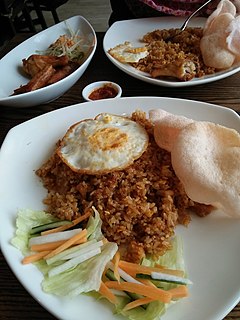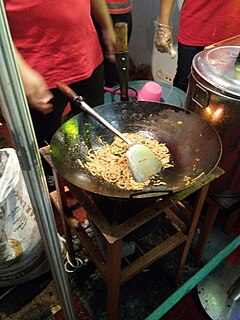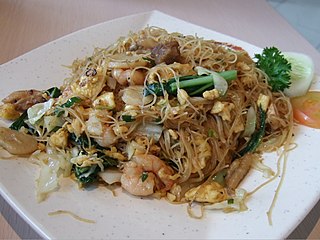
Singaporean cuisine derived from several ethnic groups which have developed through centuries of political, economic, and social changes of this cosmopolitan city-state.

Malaysian Chinese cuisine is derived from the culinary traditions of Chinese Malaysian immigrants and their descendants, who have adapted or modified their culinary traditions under the influence of Malaysian culture as well as immigration patterns of Chinese to Malaysia. Because the vast majority of Chinese Malaysians are descendants of immigrants from southern China, Malaysian Chinese cuisine is predominantly based on an eclectic repertoire of dishes with roots from Fujian, Cantonese, Hakka and Teochew cuisines.

Chinese Indonesian cuisine is characterized by the mixture of Chinese with local Indonesian style. Chinese Indonesians, mostly descendant of Han ethnic Hokkien and Hakka speakers, brought their legacy of Chinese cuisine, and modified some of the dishes with the addition of Indonesian ingredients, such as kecap manis, palm sugar, peanut sauce, chili, santan and local spices to form a hybrid Chinese-Indonesian cuisine. Some of the dishes and cakes share the same style as in Malaysia and Singapore which are known as the Nonya cuisine by the Peranakan.

Rice vermicelli is a thin form of noodle. It is sometimes referred to as 'rice noodles' or 'rice sticks', but should not be confused with cellophane noodles, a different Asian type of vermicelli made from mung bean starch or rice starch rather than rice grains themselves.

Nasi goreng is a Southeast Asian fried rice dish, usually cooked with pieces of meat and vegetables. One of Indonesia's national dishes, it is also endemic in Malay-speaking communities in countries such as Malaysia, Singapore and Brunei, and has gained popularity in Sri Lanka through migrations from the Malay Archipelago, in countries like Suriname via Indonesian immigrant communities, and in the Netherlands through its colonial ties with Indonesia. Nasi goreng is distinguished from other Asian fried rice preparations by its distinct smoky aroma, and caramelised yet savoury undertones of flavour. There is no single defined recipe for nasi goreng, and its composition and preparation varies greatly from household to household.

Fried noodles are common throughout East Asia, Southeast Asia and South Asia. Many varieties, cooking styles, and ingredients exist.

Shahe fen (沙河粉), or simply he fen (河粉), is a type of wide Chinese noodle made from rice. Its Minnan Chinese name, translated from the Mandarin 粿條 (guotiao), is adapted into alternate names which are widely encountered in Southeast Asia, such as kway teow, kwetiau, and kuetiau. Shahe fen is often stir fried with meat and/or vegetables in a dish called chao fen. While chao fen is a transliteration of Mandarin, chow fun from Cantonese is the name most often given to the dish in Chinese restaurants in North America.

Rice noodles, or simply rice noodle, are noodles made with rice flour and water as the principal ingredients. Sometimes ingredients such as tapioca or corn starch are added in order to improve the transparency or increase the gelatinous and chewy texture of the noodles. Rice noodles are most common in the cuisines of East and Southeast Asia. They are available fresh, frozen, or dried, in various shapes, thicknesses and textures. Fresh noodles are also highly perishable; their shelf life may be just several days.

Pad see ew is a stir-fried noodle dish that is commonly eaten in Thailand. It can be found easily among street food vendors and is also quite popular in Thai restaurants around the world. The origins of the dish can be traced to China from where the noodle stir-frying technique was brought.

Mie goreng, also known as bakmi goreng, is an Indonesian style of stir-fried noodle dish. It is made with thin yellow noodles stir fried in cooking oil with garlic, onion or shallots, fried prawn, chicken, beef, or sliced bakso (meatballs), chili, Chinese cabbage, cabbages, tomatoes, egg, and other vegetables. Ubiquitous in Indonesia, it is sold by food vendors from street-hawkers, warungs, to high-end restaurants.

Javanese cuisine is the cuisine of Javanese people, a major ethnic group in Indonesia, more precisely the province of Central Java, Yogyakarta and East Java.

Kwetiau goreng is an Indonesian style of stir fried flat rice noodle dish. It is made from noodles, locally known as kwetiau, which are stir fried in cooking oil with garlic, onion or shallots, beef, chicken, fried prawn, crab or sliced bakso (meatballs), chili, Chinese cabbage, cabbages, tomatoes, egg, and other vegetables with an ample amount of kecap manis. In Asia, kwetiau is available in two forms, dried and fresh. Its recipe is quite similar to another Chinese Indonesian favourite, mie goreng, with the exception of replacing yellow wheat noodles for flat rice noodles.

Mie ayam, mi ayam, or bakmi ayam is a common Indonesian dish of seasoned yellow wheat noodles topped with diced chicken meat. It is derived from culinary techniques employed in Chinese cuisine. In Indonesia, the dish is recognized as a popular Chinese Indonesian dish, served from simple travelling vendor carts frequenting residential areas, humble street-side warung to restaurants.

Char kway teow is a stir fried rice noodle dish from Maritime Southeast Asia and is of southern Chinese origin. In Hokkien and Teochew, Char means “stir-fried” and kway teow refers to flat rice noodles. It is made from flat rice noodles or kway teow of approximately 1 cm or about 0.5 cm in width, stir-fried over very high heat with garlic, light and dark soy sauce, chilli paste, whole prawns, shelled blood cockles, chopped Chinese chives, slices of Chinese sausage, and bean sprouts. Other common ingredients include fishcake and belachan.

Beef chow fun, also known as gōn cháau ngàuh hó or gānchǎo níuhé in Chinese (乾炒牛河) meaning "dry fried beef Shahe noodles", is a staple Cantonese dish, made from stir-frying beef, hor fun and bean sprouts. It is commonly found in yum cha restaurants in Guangdong, Hong Kong, and overseas, as well as in cha chaan tengs. Chow fun, or stir-fried hor fun noodles, is any number of different individual preparations. In the Philippines, it is called "Beef Hofan".

Kwetiau ayam, kuetiau ayam or sometimes kwetiau ayam kuah is a common Chinese Indonesian dish of seasoned flat rice noodles topped with diced chicken meat. It is often described as a kwetiau version of the popular mie ayam, and especially common in Indonesia, and can trace its origin to Chinese cuisine.

Indonesian noodles are a significant aspect of Indonesian cuisine which is itself very diverse. Indonesian cuisine recognizes many types of noodles, with each region of the country often developing its own distinct recipes.

Bihun goreng, bee hoon goreng or mee hoon goreng refers to a dish of fried noodles cooked with rice vermicelli in both the Indonesian and Malay languages. In certain countries, such as Singapore, the term goreng is occasionally substituted with its English equivalent for the name of the dish.

















